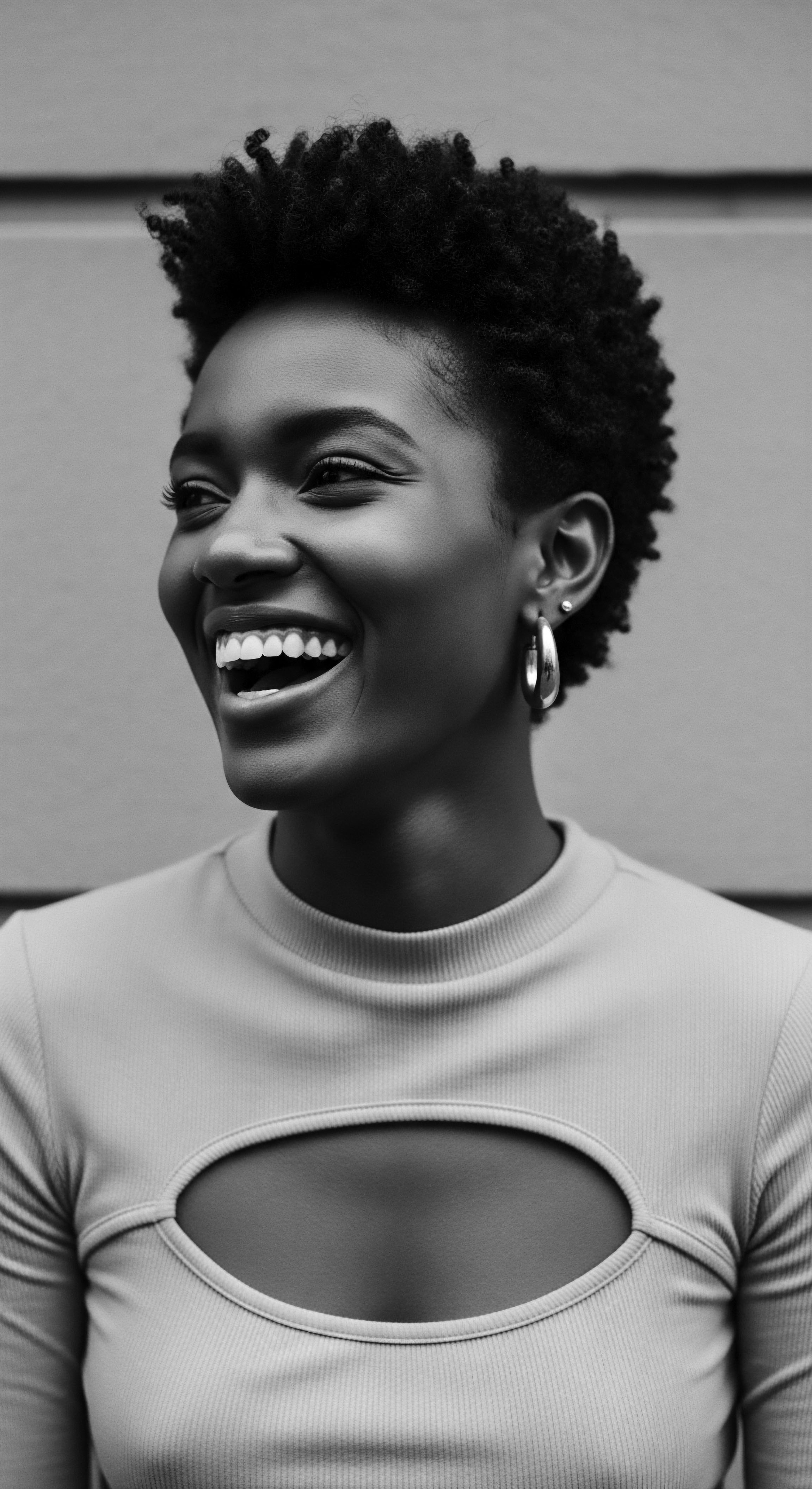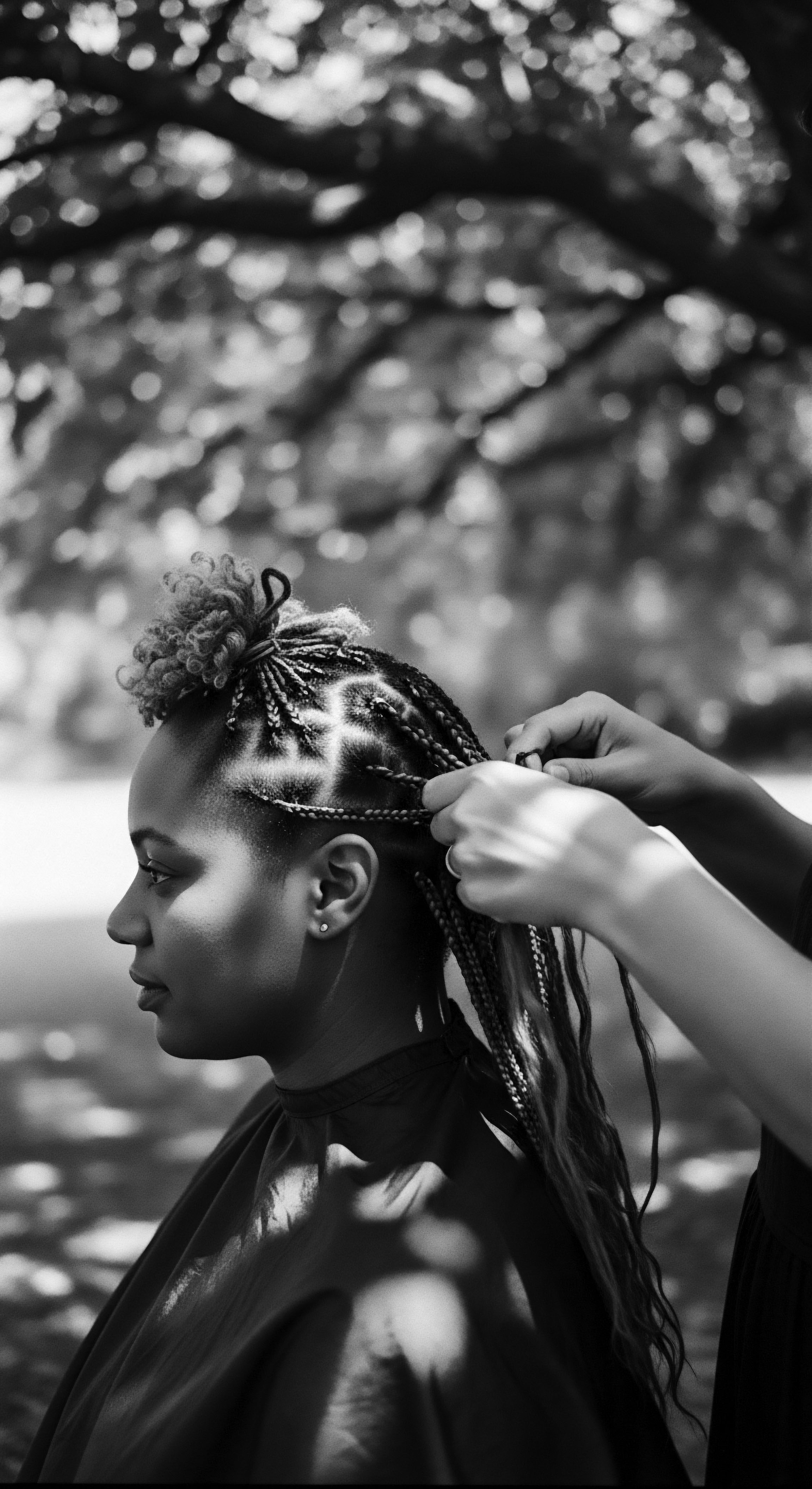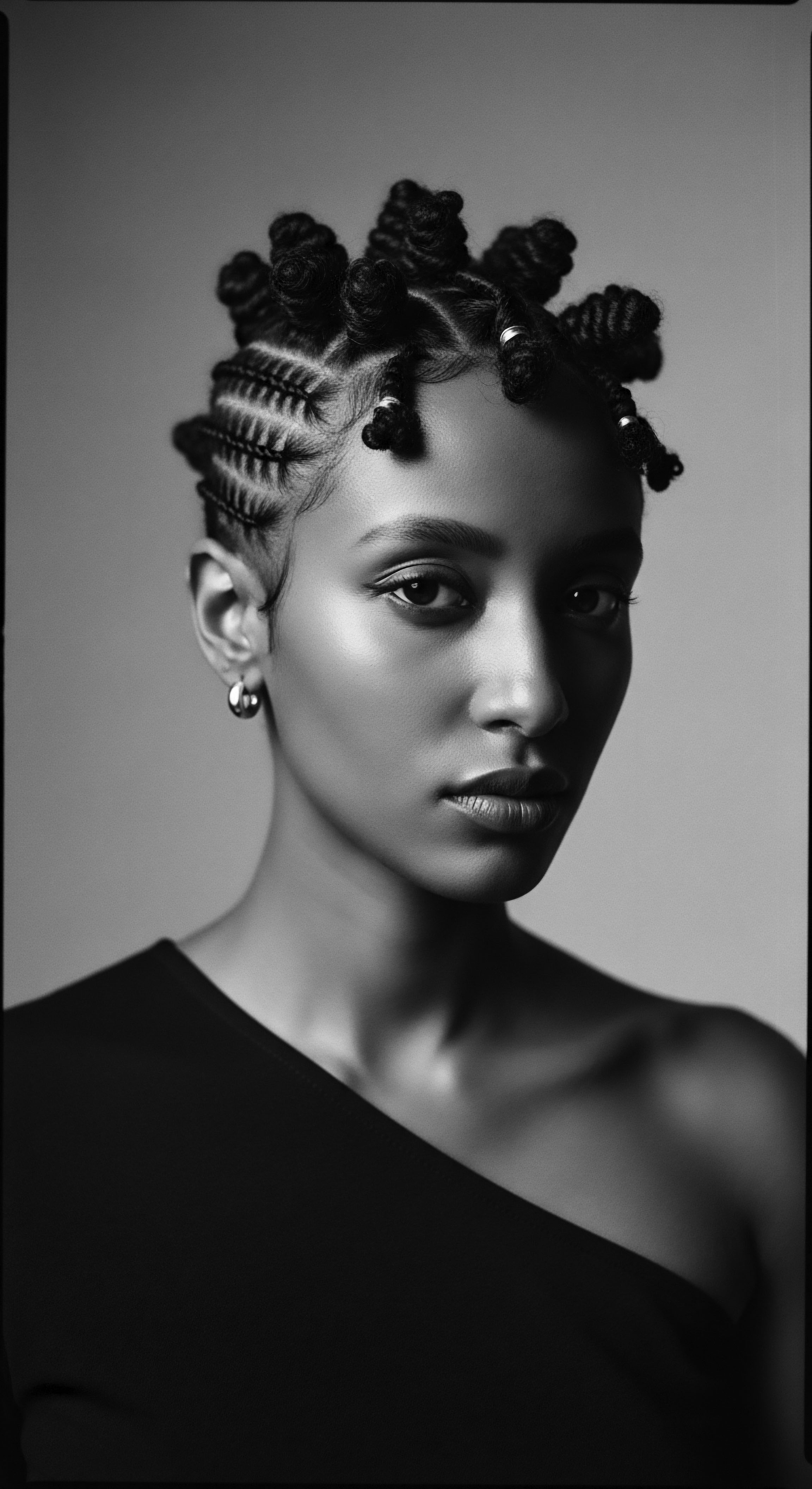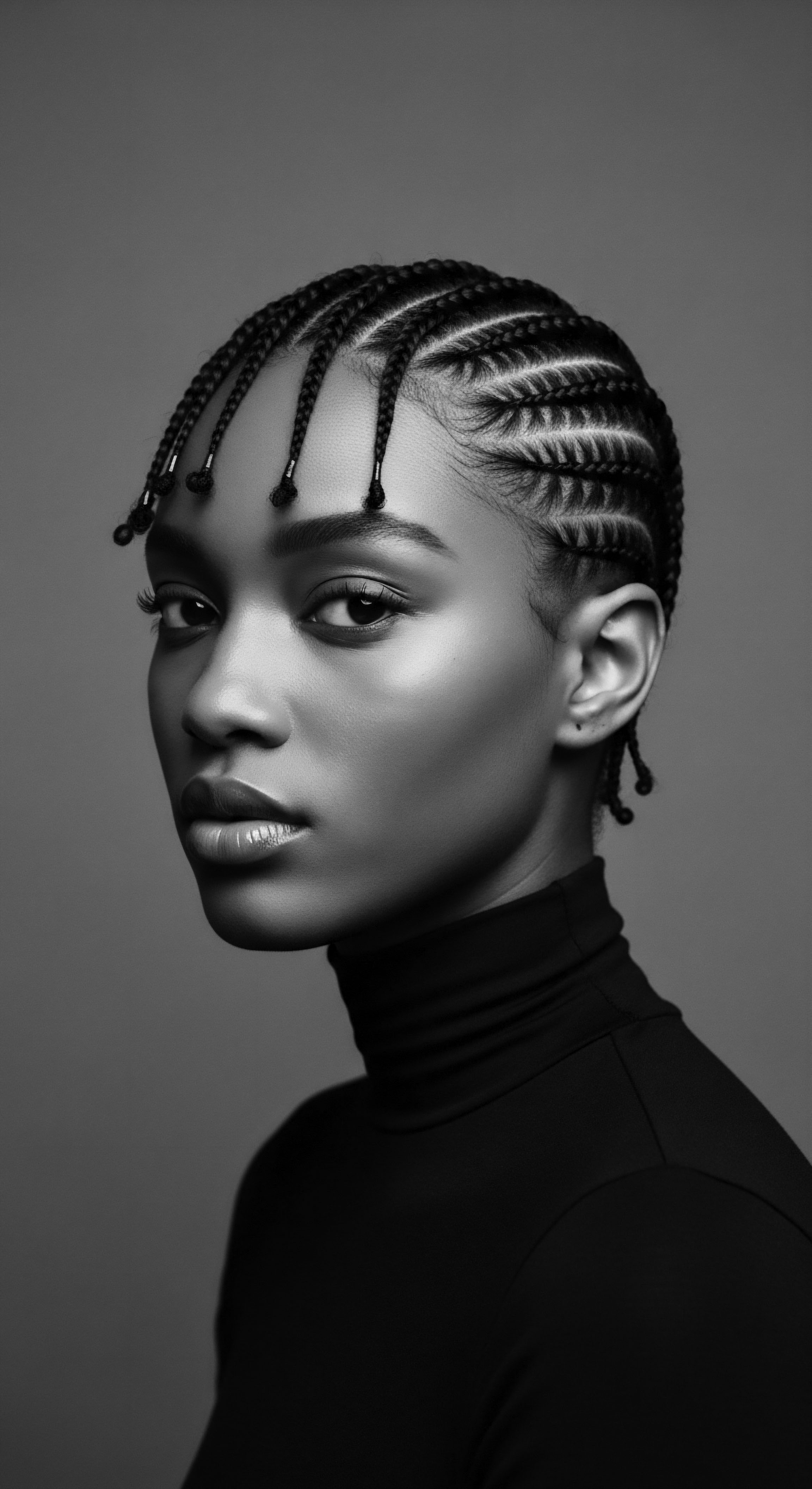
Roots
The story of textured hair, its innate qualities, and the wisdom of its care reaches back through countless generations. It is a story written in the very structure of each strand, a narrative of resilience against environmental challenges, etched into the cultural practices passed down through familial hands. For those whose crowning glory dances with tight curls, coils, and kinks, the quest for moisture is not a fleeting trend but a foundational, ancestral imperative.
Why do braids, then, stand as such powerful guardians against dryness for textured hair? The answer rests deep within the very fabric of the hair itself, whispered by ancient suns and understood by those who lived closest to the land.
Consider the unique architectural design of textured hair. Unlike straighter hair types, which possess a more circular cross-section, hair with tighter curl patterns often presents an elliptical or flattened shape. This structural distinction, combined with its naturally higher density of disulfide bonds, gives rise to the characteristic bends and twists of a coiled strand. Each bend, each turn of the helix, represents a point of potential vulnerability.
These curves create paths that make it more difficult for the scalp’s natural oils, known as sebum, to travel from the scalp down the entire length of the hair shaft. This uneven distribution leaves the ends, especially, prone to dehydration, creating a perpetual thirst within the strand. (Quinn et al. 2003) Beyond this internal geography, the cuticle, the hair’s outermost protective layer, consists of overlapping scales.
In textured hair, these scales tend to be more lifted compared to smoother hair types. This slightly open cuticle, while allowing for product penetration, also means that moisture can escape more readily into the surrounding air, making the hair susceptible to environmental dryness and humidity shifts.
The inherent architecture of textured hair, with its elliptical shape and lifted cuticle, predisposes it to moisture loss, making protective styles an ancestral response to environmental realities.
The ancestral wisdom surrounding textured hair recognized these intrinsic qualities long before scientific instruments could map them. From the arid plains of Africa to the humid climes of the Caribbean, communities observed the constant demand for hydration in these unique strands. They learned that minimizing exposure to harsh elements—be it intense sun, wind, or arid air—was paramount. Braids, therefore, arose not as a mere aesthetic choice, but as a deeply practical, biologically responsive solution.
They offered a shield, a cocoon, a way to bundle and secure the delicate strands, thereby preserving the hard-won moisture within. This profound understanding of hair’s elemental biology, intertwined with the imperative of survival, stands as a testament to the ingenuity of ancestral care.

The Ancestral Understanding of Hair’s Hydration Needs
For millennia, diverse African communities developed sophisticated systems of hair care, not through modern laboratories, but through generations of careful observation and adaptation. They understood that the very curl of the hair, while beautiful, also meant a need for diligent moisture retention. This knowledge informed the selection of natural ingredients, from rich butters to lubricating oils, and profoundly shaped styling practices. The environmental context also played a crucial role.
In varied climates, hair faced challenges. Hot, dry winds could strip moisture away, while certain forms of outdoor labor left hair exposed to damaging sunlight and physical abrasion. Braiding offered a defense, a means to keep the hair cloaked and safeguarded.
- Shea Butter ❉ Across West Africa, shea butter, extracted from the nuts of the shea tree, served as a foundational emollient, providing deep, lasting moisture to hair and scalp. (Safo Hair, 2024)
- Coconut Oil ❉ In coastal regions and diasporic communities, coconut oil provided a sealant, helping to lock in hydration and impart a natural luster to the hair.
- Aloe Vera ❉ Used across various traditions, the gel from the aloe vera plant offered soothing properties and provided a refreshing, water-based hydration to the strands. (Rayat Bahra International Journal of Multidisciplinary Research, 2024)
These elements, applied with intention and skill, prepared the hair for the protective embrace of braids. The braids themselves then amplified the effects of these applications, holding the moisture close to the hair shaft and allowing it to penetrate more deeply, far from the drying touch of the elements. It represents a living history of proactive care, a direct answer to the hair’s intrinsic thirst.

Ritual
The act of braiding textured hair transcends simple styling; it becomes a ritual, a communal gathering, a transfer of wisdom, and a profound declaration of identity. This practice, woven into the fabric of daily life and special occasions across Black and mixed-race communities for centuries, serves as a cornerstone of hair wellness. Beyond its aesthetic appeal, the ritual of braiding actively safeguards the hair from the relentless assault of environmental factors and the cumulative damage of daily manipulation. It is here, in the gentle rhythm of sectioning, twisting, and interlacing, that braids truly begin their work of protecting hair from becoming dry.
Consider the daily life of an individual with textured hair. Each comb stroke, each styling attempt, each exposure to wind, sun, or the friction of fabrics contributes to moisture loss and potential breakage. Textured hair, by its very nature, is more prone to tangles and knots. (British Association of Dermatologists, 2023) The very act of detangling can be a strenuous process, often leading to mechanical damage and the erosion of the hair’s precious hydration.
When hair is braided, it is collected, aligned, and tucked away. This physical containment dramatically reduces the hair’s surface area exposed to the atmosphere, thereby minimizing the rate at which moisture evaporates. The tightly interwoven strands create a localized, humid microclimate around the hair, effectively sealing in any applied moisturizers and preventing their rapid escape. This ‘sealing’ action is a primary reason why braids function as a shield against desiccation.
Braiding transforms daily hair maintenance into a deliberate act of preservation, creating a microclimate that shields delicate strands from environmental moisture depletion.

How Does Braiding Diminish Environmental Exposure?
The physical structure of a braid acts as a formidable barrier. Wind, for example, can cause hair strands to rub against each other, creating friction that lifts the cuticle and accelerates moisture evaporation. Sunlight, particularly its ultraviolet rays, can degrade hair proteins and dry out the hair shaft.
Braids mitigate these effects by keeping the individual strands bound together, reducing the hair’s movement and limiting direct contact with harsh environmental elements. This also significantly lessens physical abrasion from clothing, pillows, or everyday activities, which are common culprits in causing friction and subsequently, dryness and breakage.
This protective quality was recognized and relied upon by ancestors facing extreme conditions. During the transatlantic slave trade, when individuals were forcibly removed from their lands and subjected to unimaginable brutality, hair care practices became acts of resistance and survival. Enslaved Africans, stripped of their material possessions and cultural identity, ingeniously used cornrows, a specific form of braiding that lies flat against the scalp, to conceal seeds and grains for sustenance during perilous journeys and to create maps for escape routes.
(Loftis, 2025; Sartorial Magazine) While the primary aim was survival, the inherent nature of these braided styles also served a vital, practical purpose ❉ preserving the hair’s integrity and moisture in conditions that would otherwise devastate it. This historical example powerfully illuminates how braids were not only a means of cultural continuity and defiance but also a pragmatic tool for maintaining hair health under severe duress, making the protection from drying out a critical, albeit sometimes secondary, benefit.

Ancestral Practices ❉ Beyond Simple Adornment
The care rituals surrounding braids were comprehensive. Before braiding, hair was often cleaned using natural cleansers like yucca root or African black soap, followed by conditioning with plant extracts. Oils and butters, like those from shea, mango, or palm, were then worked into the strands, coating them with a protective layer. This layering of moisture and sealant, then encased within the braid, provided a sustained hydration system.
The braids locked in these emollients, allowing them to slowly nourish the hair over days or weeks, preventing the rapid loss that would occur with loose hair. This systematic approach, inherited through generations, stands as a testament to deep knowledge of natural materials and their interaction with hair.
| Traditional Principle Moisture Retention |
| Ancestral Practice Coating hair with natural oils/butters (e.g. shea, coconut) prior to styling. |
| Modern Scientific Link Lipids (oils) act as occlusives, forming a barrier to reduce transepidermal water loss from the hair shaft. |
| Traditional Principle Minimizing Manipulation |
| Ancestral Practice Wearing braids, twists, or locs for extended periods. |
| Modern Scientific Link Reduces mechanical stress from combing, brushing, and daily styling, preserving hair cuticle integrity. (Journal of Cosmetic Science, 2014) |
| Traditional Principle Environmental Shield |
| Ancestral Practice Hair tucked away in braids, often covered with headwraps. |
| Modern Scientific Link Lessens exposure to drying sun, wind, and low humidity, maintaining a humid microenvironment around the strands. |
| Traditional Principle Nutrient Delivery |
| Ancestral Practice Applying herb-infused oils and scalp massages. |
| Modern Scientific Link Stimulates blood flow to the scalp and delivers beneficial compounds to follicles and hair shaft. |
| Traditional Principle These ancestral principles, deeply ingrained in textured hair heritage, align with contemporary understanding of hair physiology, underscoring the timeless wisdom of traditional care. |
These practices underscore a deep respect for the hair’s nature and a recognition of its needs. The braiding ritual, often performed by family members, strengthened communal bonds while ensuring the physical well-being of the hair. It was a holistic act, nurturing both the individual and the collective spirit, all while providing tangible, physical protection against environmental drying. The longevity of these styles, often worn for weeks, meant reduced daily effort and consistent protection, allowing the hair to rest and retain its vital moisture.

Relay
The wisdom of braiding, passed through generations, continues to guide contemporary hair care for textured strands, affirming its foundational role in moisture preservation. Modern scientific inquiry now provides explanations for what ancestral hands intuitively understood ❉ braids create an environment conducive to hair health, particularly in combating dryness. The mechanics involved are simple, yet profoundly effective, resonating with principles of physical protection and moisture equilibrium.
Textured hair, with its unique morphology, is predisposed to dryness. The spiral structure, while captivating, also means that the hair shaft is not uniformly coated by the scalp’s natural sebum. This, combined with the often more open cuticle structure, allows moisture to dissipate relatively easily into the atmosphere. The act of braiding mitigates these challenges by physically bundling the hair.
This bundling significantly reduces the surface area of the hair exposed to drying air, wind, and direct sunlight. It creates a compact structure that limits the rate of water evaporation from the hair’s inner cortex. This encapsulation establishes a localized microclimate around the hair, maintaining a higher humidity level within the braid itself. The effect is akin to placing a lid on a pot of simmering water; the moisture, instead of escaping freely, remains trapped within the confined space, allowing the hair to remain hydrated.
Braids reduce environmental exposure and mechanical stress on hair, allowing it to retain moisture more effectively by creating a protective, localized microclimate.

What is the Mechanical Advantage of Braids in Moisture Retention?
The mechanical aspects of braiding contribute significantly to moisture retention. By tightly binding individual strands into a coherent unit, braids reduce the hair’s susceptibility to physical manipulation. Daily combing, brushing, and styling cause friction and abrasion, which can lift the cuticle, making the hair porous and allowing moisture to escape. These daily stressors also lead to tangles and knots, which are points of weakness and sources of breakage.
When hair is secured in braids, these daily mechanical forces are drastically reduced. This stillness lessens the wear and tear on the hair shaft, helping to keep the cuticle smooth and intact, thereby reinforcing its natural barrier function against moisture loss.
A study in the Journal of Cosmetic Science by Vermeer and Apeldoorn (2014) found that hydrated hair exhibits greater elasticity and is less prone to breakage when manipulated. This scientific observation aligns with the benefits of braids ❉ by keeping hair hydrated, braids indirectly contribute to its strength and reduce breakage that would otherwise compromise its health. Furthermore, Davis-Sivasothy (2011), in the International Journal of Trichology, highlights the importance of combining water-based sprays with oils to lock in hydration for textured hair. Braids act as the perfect container for such practices.
Once moisturizers and sealants are applied, the braided structure physically holds them against the hair strands, allowing for deeper penetration and longer-lasting hydration. This contrasts with loose hair, where products might evaporate or rub off more quickly.

How do Braids Safeguard Hair from Breakage and External Forces?
The resilience of textured hair, while remarkable, is also accompanied by a heightened susceptibility to breakage, a characteristic amplified by frequent manipulation and environmental aggressors. The very twists and turns of each strand, while defining its character, also represent points of vulnerability. Braids serve as a profound countermeasure to this fragility. They minimize exposure to various external forces that compromise hair health.
- Friction Reduction ❉ When hair is left loose, strands rub against each other, against clothing, and against pillowcases. This constant friction lifts the hair’s outer cuticle, leading to roughness, dryness, and eventually, breakage. Braids bundle the hair, significantly reducing inter-strand and external friction.
- Environmental Shielding ❉ Direct exposure to drying elements such as harsh winds, low humidity, and intense sunlight strips moisture from the hair. Braids envelop the hair, acting as a physical barrier that shelters the inner strands from these dehydrating forces.
- Reduced Manipulation ❉ Loose textured hair often requires daily combing and styling to manage tangles and maintain a desired look. Each act of manipulation can cause mechanical stress. Braids, once installed, require minimal daily handling, granting the hair a period of rest and reducing accumulated stress.
This reduction in manipulation is a cornerstone of length retention for textured hair. When hair is constantly subjected to styling and detangling, the rate of breakage can sometimes equal or exceed the rate of growth, giving the impression that the hair is not growing. By minimizing breakage, braids allow the hair to reach its full length potential while maintaining its health.
The efficacy of braids extends beyond simply protecting from physical forces. They create a stable environment that supports the efficacy of applied products. When hydrating leave-in conditioners and sealing oils are applied to hair before braiding, the braided structure helps to hold these products close to the hair shaft. This prolonged contact allows for deeper absorption and extended benefit, ensuring that the moisture is not merely applied, but truly locked in.
The consistent, gentle pressure of the braid also contributes to a more uniform distribution of oils along the length of the strand, compensating for the natural difficulty sebum faces in traveling down a coiled fiber. This synergy between physical protection and product retention is a core scientific basis for why braids are so effective at preventing textured hair from drying out, a testament to the ongoing validity of practices rooted in ancestral experience.

Reflection
The story of braids and their protective power for textured hair is more than a scientific exposition or a historical account; it is a profound echo of heritage, a living testament to ancestral brilliance. It is a dialogue between the elemental biology of the strand and the communal wisdom that learned to nurture it, a conversation carried across continents and centuries. Roothea’s ‘Soul of a Strand’ ethos acknowledges that each coil and curve holds not only the blueprint of its unique structure but also the weight of generations who navigated environmental challenges with ingenuity and deep care.
The braided style, whether it be intricate cornrows that once carried escape routes, Himba otjize-coated plaits designed for sun protection (Malgas et al. 2022), or the enduring box braids of today, stands as a symbol of adaptability and survival. It speaks of a time when beauty practices were inseparable from wellness and resilience, when caring for one’s hair was an act of self-preservation and cultural affirmation.
This enduring legacy teaches us that true hair wellness goes beyond superficial appearance; it is rooted in understanding our hair’s inherent nature, respecting its historical journey, and honoring the wisdom that has kept it thriving against immense odds. The protective braid, in its elegant simplicity, continues to remind us that the best care for textured hair is often a return to practices that held our ancestors.

References
- Davis-Sivasothy, T. (2011). The Science of Black Hair ❉ A Comprehensive Guide to Textured Hair Care. SIVASOTHY, T.
- Loftis, A. (2025). Braids, Locs, and Beyond ❉ The Beauty and History of Protective Styles. Sartorial Magazine .
- Malgas, V. Dube, M. & Matjila, C. (2022). Quantifying the impact of braiding and combing on the integrity of natural African hair. Journal of Cosmetic Dermatology .
- Quinn, C. R. et al. (2003). Hair care practices in African American women. Cutis, 72(4), 280-282, 285-289.
- Rayat Bahra International Journal of Multidisciplinary Research. (2024). Sustainable solution for scalp ❉ Utilizing herbs for healthy hair growth. Rayat Bahra International Journal of Multidisciplinary Research, 10(1), 74-80.
- Rosado, S. (2003). The grammar of hair ❉ An ethnographic study of hair care rituals among women of African descent. Journal of Social Issues .
- Safo Hair. (2024). Embracing the Roots ❉ Hair Care Rituals in African Cultures and the Valuable Lessons We Can Learn.
- Vermeer, C. & Apeldoorn, I. (2014). The effect of hair hydration on hair breakage. Journal of Cosmetic Science, 65(4), 241-247.
